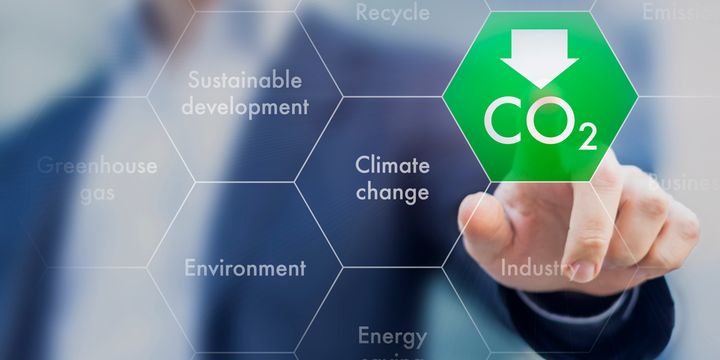Photo: Gettyimages.com/NicoElNino
A “tank-to-wheel” approach of calculating CO2 emissions combines both the European Norm 16258 and the SmartWay Truck Carrier Tool as key indicators.
Greenhouse gases contribute to the global climate change problem and cause air pollution to spike to crisis levels in some urban areas.
Carbon dioxide emissions are a major source of greenhouse gases around the world, and a significant portion of those come from transportation. In the U.S., for instance, 28% of CO2 emissions are produced by the transportation sector. In the UK, the transportation industry accounts for more than a third of CO2 emissions – and road vehicles contribute the most CO2 emissions in transportation sector activities.
These greenhouse gases build up over time in the atmosphere, creating a cumulative effect. The cumulative nature is what makes tracking emissions crucial — we have to understand how much CO2 is being released to know where we stand. But we can’t effectively track emissions without a standard, simplified approach to reporting.
The Disconnect Between Regional Government and Business CO2 Tracking Standards
Air pollution last year was reduced by lockdowns imposed as a response to the pandemic, but because greenhouse gases build up over time, a temporary reduction in emissions doesn’t solve the long-term problem.
Governments and businesses have policies in place to make transportation more sustainable (and this will be a major push under the new Biden administration). A key part of the effort is tracking emissions.
The problem is that while the fight against climate change has to be waged globally, there’s no universal standard that every organization uses to calculate emissions. There’s a disconnect because of the variety of calculation methods.
The disconnect is especially pronounced when global transportation companies use local methods to calculate emissions. There’s significant pressure on companies to commit to reducing their carbon footprint. In some regions, government regulations are increasing. This highlights why it’s so important to find a standard way to calculate emissions for effective tracking.
Combining Regional Standards for a Better CO2 Tracking Methodology
In Europe, most transportation companies use the European Norm 16258 to calculate greenhouse gas emissions. In North America, many shippers use the SmartWay Truck Carrier Tool to calculate total emissions. The use of these different standards makes it difficult to monitor the global effect of emissions.
A “tank-to-wheel” approach combines both the European Norm 16258 and the SmartWay Truck Carrier Tool as key indicators. Transportation companies that are looking for a standard way to calculate emissions should consider using a method that accounts for vehicle type, fuel use, and direct emissions by route, since that approach includes static and individual standards.
The key to accurate calculations is to find a simple way to update vehicle setup and develop trip-based calculations via a web service. With this solution in place, the company can access detailed projections of planned route factors and create estimates for each leg of the trip and total expenses per trip. Ideally, the estimate would provide fuel and labor costs in addition to greenhouse gas emissions per route, providing a complete picture.
A True Picture of Greenhouse Gas Costs

Fleets looking for a standard approach to emissions monitoring should look for a web-based solution that allows them to customize calculation methodologies to meet their needs. Graphic: Trimble Maps
Companies that have a standard calculation approach delivered via a web service can track greenhouse gas emissions in their operations worldwide. A method that combines regional standards enables a direct comparison between operating units located in different countries.
And when fuel and labor costs are also calculated in a web service solution, companies can get higher quality reports with more detail about those aspects of operations in addition to greenhouse gas emissions, all in one place. Centralized reporting and dashboards can provide a clearer picture.
Having a standard way to calculate emissions is critical because it allows the company to monitor emissions and track reduction program progress over time. It gives companies the complete picture they need to make the best decisions about purchasing or replacing fleet vehicles and investing in energy savings at levels that work best for their business.
A standard approach also enables transportation companies to comply with regulations and legal requirements for emissions tracking. And as new regulations are enacted and customers put new greenhouse gas policies into effect, a standard approach simplifies compliance every step of the way.
Companies that are looking for a standard approach to emissions monitoring should look for a web-based solution that allows them to customize calculation methodologies to meet their needs — by supporting the European Norm 16258, SmartWay and also the Handbook of Emission Factors for Road Transport (version 3.2). A flexible solution that simplifies reporting makes compliance easier and helps companies reduce greenhouse gases to fight climate change.
Abigail Obano leads product marketing in the EMEA (Europe, Middle East and Africa) region for Trimble Maps, which offers the kind of tracking mentioned in this article through its PC Miler solutions. This article was authored under the guidance and editorial standards of HDT’s editors to provide useful information to our readers.
CUT COTS OF THE FLEET WITH OUR AUDIT PROGRAM
The audit is a key tool to know the overall status and provide the analysis, the assessment, the advice, the suggestions and the actions to take in order to cut costs and increase the efficiency and efficacy of the fleet. We propose the following fleet management audit.




